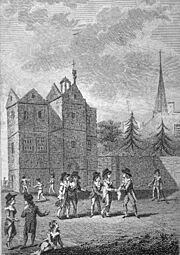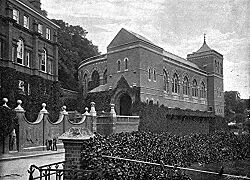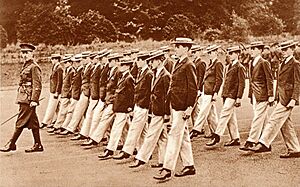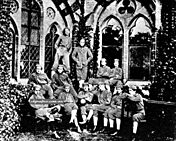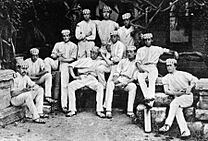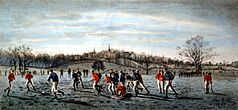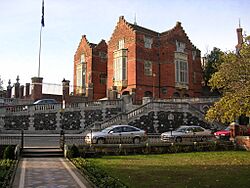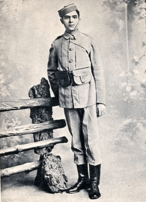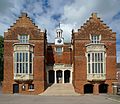Harrow School facts for kids
Quick facts for kids Harrow School |
|
|---|---|
 |
|
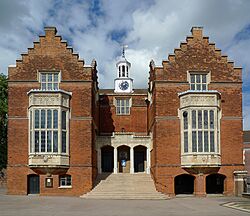
The Old Schools photographed in 2013
|
|
| Address | |
|
5 High Street, Harrow on the Hill
, Middlesex
,
HA1 3HP
England
|
|
| Coordinates | 51°34′21″N 00°20′06″W / 51.57250°N 0.33500°W |
| Information | |
| Type | Public school Private boarding school |
| Mottoes | Latin: Stet Fortuna Domus (Let the Fortune of the House Stand) Latin: Donorum Dei Dispensatio Fidelis (The Faithful Dispensation of the Gifts of God) |
| Religious affiliation(s) | Church of England |
| Established | 1572 (Royal Charter) |
| Founder | John Lyon of Preston |
| Department for Education URN | 102245 Tables |
| Chairman of the Governors | J P Batting |
| Head Master | Alastair Land |
| Staff | ~200 (full-time) |
| Gender | Male |
| Age | 13 to 18 |
| Enrollment | ~830 pupils |
| Houses | 12 |
| Colour(s) | Blue and white |
| Song | "Forty Years On" |
| Publication | The Harrovian |
| School fees | £46,710 |
| Alumni | Old Harrovians |
| Badges | The Harrow Lion The Silver Arrow |
Harrow School is a famous public school for boys in Harrow on the Hill, London, England. It is a boarding school, meaning students live there during term time. The school was started in 1572 by John Lyon, a local farmer. He received special permission from Queen Elizabeth I to open it.
Today, about 830 boys attend Harrow School. All of them live in one of the twelve boarding houses. Harrow is known for its unique uniform. This includes morning suits, straw boater hats, and sometimes even top hats and canes.
Many important people have studied at Harrow. This includes seven former British prime ministers. Some famous names are Winston Churchill and Robert Peel. The first Prime Minister of India, Jawaharlal Nehru, also went to Harrow. The school has also educated Nobel Prize winners and many other well-known figures.
Contents
History of Harrow School
Harrow School began in February 1572. Queen Elizabeth I gave a special document, called a royal charter, to John Lyon. He was a rich farmer who wanted to create a school for his local area. The school's full name is still 'The Free Grammar School of John Lyon within the town of Harrow-on-the-Hill'.
John Lyon passed away in 1592. He left his money to two things: the school and the upkeep of two roads leading to London. The roads received more money at first. This was important for moving goods to market. In 1991, the money for the roads was moved to a charity. This charity helps with education in the local areas.
The first school building, called the Old Schools, was finished in 1615. This was after John Lyon's wife died in 1608.
Who Could Attend Harrow School?
John Lyon's school was first meant to teach 30 (later 40) poor boys from the local area for free. However, the Head Master could also accept "foreigners." These were boys from outside the parish who paid fees. These "foreigners" needed places to stay, which led to the idea of boarding at the school. Like other schools at the time, lessons focused on ancient Greek and Roman languages and culture.
As Harrow School became more famous, more boys from outside the area joined. Local families sometimes found the classical education less useful for their children. So, the number of free students went down. By 1825, there were 17 free students and 219 paying students.
In 1876, a new school was started for local boys. It was called the Lower School of John Lyon. This school offered a more modern education. Today, it is known as The John Lyon School. It is an independent school and still part of the Harrow School Foundation.
Historic Buildings at Harrow
The Old Schools building from 1615 is still mostly the same. It was updated in 1818 by Charles Robert Cockerell. It is a very important historic building, known as a Grade I listed building.
Many of the school's boarding houses were built in Victorian times. This was when the number of students grew a lot. Other important buildings include the Speech Room (1877) by William Burges. The chapel (1855) and Vaughan Library (1863) were both designed by George Gilbert Scott. The War Memorial building (1926) was designed by Herbert Baker. It remembers students who died in the First World War. These buildings are all Grade II* listed buildings. In total, 27 school buildings have a Grade II listing.
School Traditions and Customs
What is Harrovian Blue?
The school's special colour is navy blue. It is often called Harrovian Blue. This colour is used for uniforms and sports clothes. The colour Oxford Blue is thought to have been inspired by Harrovian Blue. This happened during the first university boat race in 1829. Two crew members from Oxford, Charles Wordsworth and Thomas Garnier, had both attended Harrow School. They chose the Oxford colours.
Harrow School Uniform
For everyday wear, boys at Harrow wear a dark blue jacket called a "bluer." They also wear light grey trousers, known as "greyers." With these, they wear a white shirt, black tie, and black shoes. They can also wear an optional blue jumper.
A special part of the uniform is the Harrow hat. This is a straw hat with a dark blue band. It looks like a boater hat but is a bit different. In cold weather, boys can wear a blue and white woollen scarf and a dark blue woollen overcoat.
Some students have special uniform items. Monitors (older students who help lead) can wear a jumper of any colour they choose. Members of certain clubs can wear different scarves or ties instead of the standard school tie.
For Sundays and special events, boys wear a black tailcoat. They also wear a black waistcoat and striped trousers. This is worn with a white shirt and black tie. Students who excel in sports can wear a grey double-breasted waistcoat. Members of the Guild (for art, music, or drama achievements) wear maroon waistcoats and bow ties. Members of the Philathletic Club (for sports achievements) wear black bow ties with grey waistcoats. School monitors can wear black double-breasted waistcoats, a top hat, and carry canes.
Harrow's School Houses
| House name and Colours | |
|---|---|
| Bradbys – Purple and White (DJE) | |
| Druries – Red and Black (BTM) | |
| Elmfield – Purple and Black (AJC) | |
| Gayton – (over-spill house) (NSK) | |
| The Grove – Red and Blue (AGC) | |
| The Headmaster's – Pink and White (MJT) | |
| The Knoll – Gold and Black (CO) | |
| Lyon's – Green and Black (NJM) | |
| Moretons – White and Blue (SMS) | |
| Newlands – Yellow and White (HKJ) | |
| The Park – Red and White (BJDS) | |
| Rendalls – Magenta and Silver (ADJT) | |
| West Acre – Red, White and Blue (HAH) | |
All students at Harrow School live in one of the twelve Houses. Each House has about seventy boys. There is also a thirteenth house, Gayton, used when other houses are full. Each House has its own facilities, traditions, and competes in sports against the others.
House Masters, Assistant House Masters, and their families live in the Houses. They are helped by House Tutors from the teaching staff. The House Master looks after the well-being of every boy in their House. They are the main contact for parents. Each House also has a resident matron and a sick room. The matrons are supported by the School's Medical Centre. This centre has trained nurses who provide care all day and night. The school doctor is also available daily for consultations.
Boys do not sleep in large dormitories. For their first few terms, boys share a room. After that, they get their own room.
Harrow Songs and Music
The school has a special book of songs. The most famous one is Forty Years On. In the 1800s, many schools had a school song. Harrow had a teacher named Edward Ernest Bowen, who was a poet and music teacher. They also had John Farmer, a composer. Between 1870 and 1885, they wrote many songs about school life. These songs became very popular because of their inspiring and fun words and catchy tunes.
New songs have been added to the collection over the years. The songs are sung in House and School concerts several times each term. Winston Churchill, a former student and Prime Minister, loved Harrow songs. He returned for a concert in 1940, which became the first of many yearly visits. "Churchill Songs" is still celebrated every year in the Speech Room. Every five years, a larger concert is held at the Royal Albert Hall.
Sports at Harrow School
The sport of squash was created at Harrow around 1830. It developed from another game called rackets. Squash then spread to other schools and became an international sport.
Harrow School plays an annual cricket match against Eton College. This match has been held at Lord's Cricket Ground since 1805. It is thought to be the longest-running cricket game in the world. It is also the oldest game played at Lord's. Eton won in 2013, and Harrow won in 2014 and 2015.
Harrow also has its own special style of football called Harrow Football. The school offers about 30 different sports activities for students. These include archery, badminton, hockey, and judo.
Harrow School in the Media
In 2005, Harrow School was one of many independent schools that were found to have shared information about fees. This was against a new law. The schools said they did not know it was against the law. Each school paid a small fine. They also agreed to pay a total of £3,000,000 into a fund. This fund was set up to help students who attended the schools during that time.
Harrow was shown in a Sky 1 TV show called Harrow: A Very British School in 2013.
Famous Former Students (Old Harrovians)
Students who have graduated from Harrow are known as Old Harrovians. As mentioned, seven British prime ministers attended the school. These include Winston Churchill, Stanley Baldwin, and Robert Peel. Jawaharlal Nehru, the first Prime Minister of India, also studied here. Twenty Old Harrovians have received the Victoria Cross for bravery.
Five kings or leaders of countries have attended Harrow:
- King Hussein of Jordan
- Both Kings of Iraq, Ghazi I and his son Faisal II
- The current Emir of Qatar, Sheikh Tamim bin Hamad Al Thani
- Ali bin Hamud of Zanzibar
Harrow has also educated several Nobel Prize winners:
- John William Strutt, 3rd Baron Rayleigh, who won the Nobel Prize in Physics in 1904.
- John Galsworthy, who won the Nobel Prize in Literature in 1932.
- Winston Churchill, who also won the Nobel Prize in Literature in 1953.
Other famous former students include writers like Lord Byron and Anthony Trollope. Military leaders such as Harold Alexander, 1st Earl Alexander of Tunis also attended. Business leaders like Nicky Oppenheimer (from DeBeers) and Julian Metcalfe (who founded Pret a Manger) are Old Harrovians.
In sports, Harrow produced the first two Wimbledon champions: Spencer Gore and Frank Hadow. C. W. Alcock, who founded the FA Cup, also went to Harrow. Recent England rugby players like Billy Vunipola, Maro Itoje, and Henry Arundell are also Old Harrovians.
In the arts and media, famous alumni include actors Edward Fox, Benedict Cumberbatch, and Cary Elwes. Singers David Dundas and James Blunt also studied at Harrow.
Some fictional characters have also been said to attend Harrow. These include Brett Sinclair from the TV show The Persuaders! and Herbert Pocket from Charles Dickens's novel, Great Expectations.
Notable Staff Members
Many talented people have worked at Harrow School as teachers or staff. Here are a few:
- Joe Ansbro (born 1985): An international rugby player for Scotland. He taught biology and coached rugby at Harrow.
- David Elleray (born 1954): A retired Premier League and FIFA referee. He was a Housemaster and Head of Geography.
- Robert Key (born 1945): A politician who taught economics at Harrow from 1969 to 1983.
- Malcolm Nokes (1897–1986): A soldier, airman, Olympic medallist, and nuclear scientist. He was a chemistry teacher and later Head of Science.
- Roger Uttley (born 1949): A retired England rugby captain. He was Head of Physical Education and coached the 1st XV rugby team.
Directors of Music
- John Farmer, 1862–1885
- Eaton Faning, 1885–1901
- Percy C. Buck, 1901–1927
- R. S. Thatcher, 1927–1936
- Richard Drakeford, 1976–1985
- Richard Walker, 1985-2005
- David Woodcock, 2005–present
Head Masters of Harrow School
- 1608–1611 Anthony Rate
- 1611–1615 Thomas or Henry Bradley
- 1615–1621 William Launce
- 1621–1628 Robert Whittle
- 1628–1661 William Hide
- 1661–1668 Thomas Johnson
- 1668–1669 Thomas Martin
- 1669–1685 William Horne
- 1685–1691 William Bolton
- 1692–1730 Thomas Brian
- 1730–1746 James Cox
- 1746–1760 Thomas Thackeray
- 1760–1771 Robert Carey Sumner
- 1771–1785 Benjamin Heath
- 1785–1805 Joseph Drury
- 1805–1829 George Butler
- 1829–1836 Charles Longley
- 1836–1844 Christopher Wordsworth
- 1845–1859 Charles John Vaughan
- 1860–1885 Henry Montagu Butler
- 1885–1898 James Welldon
- 1898–1910 Joseph Wood
- 1910–1925 Lionel Ford
- 1926–1934 Cyril Norwood
- 1934–1939 Paul Cairn Vellacott
- 1940–1942 Paul Boissier
- 1942–1953 Ralph Westwood Moore
- 1953–1971 Robert Leoline James
- 1971–1981 Michael Hoban
- 1981–1991 Ian David Stafford Beer
- 1991–1999 Nicholas Raymond Bomford
- 1999–2011 Barnaby Lenon
- 2011–2018 Jim Hawkins
- 2018–2019 Mel Mrowiec (interim)
- 2019–present Alastair Land
Images for kids
See also
 In Spanish: Harrow School para niños
In Spanish: Harrow School para niños


